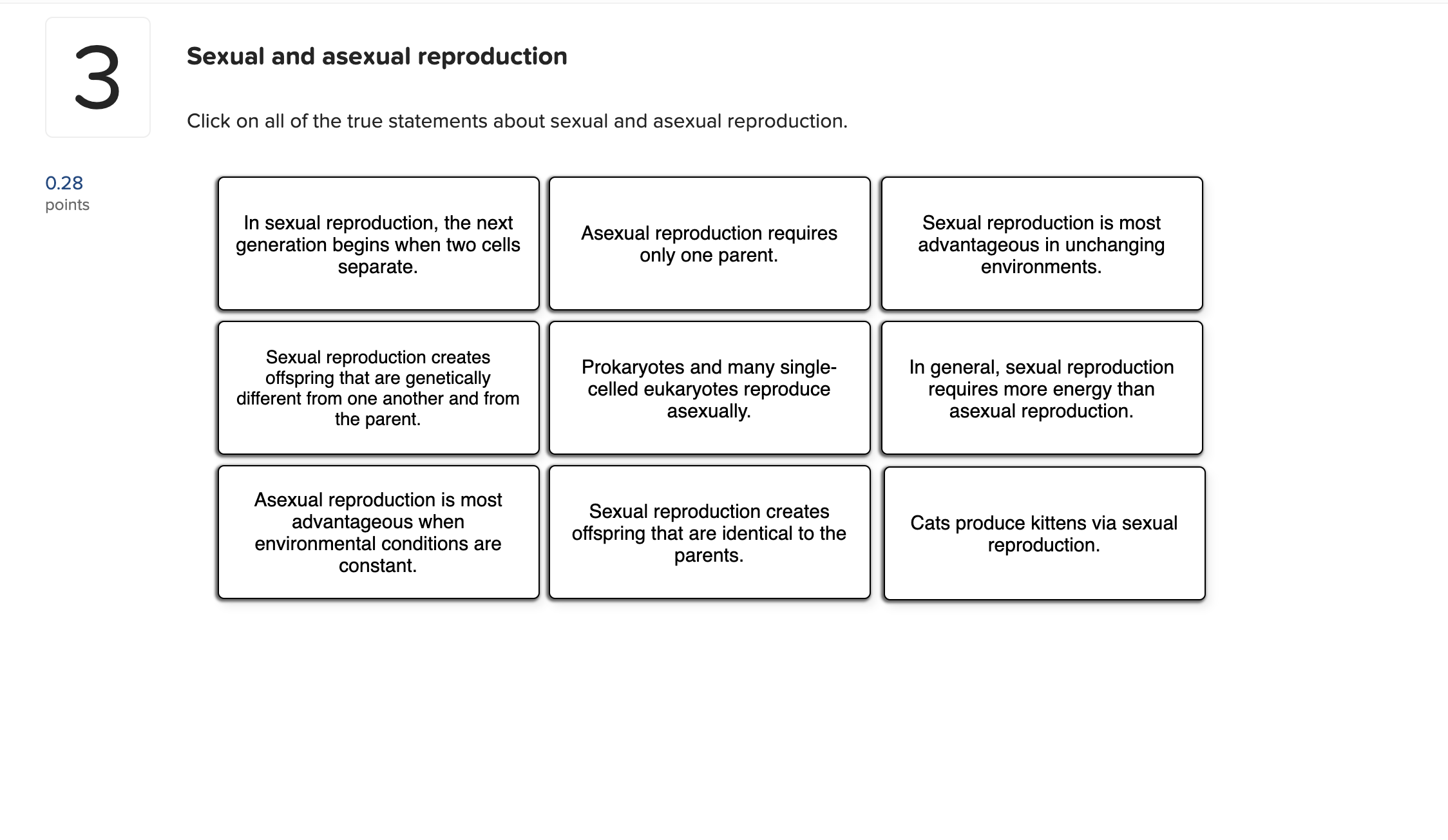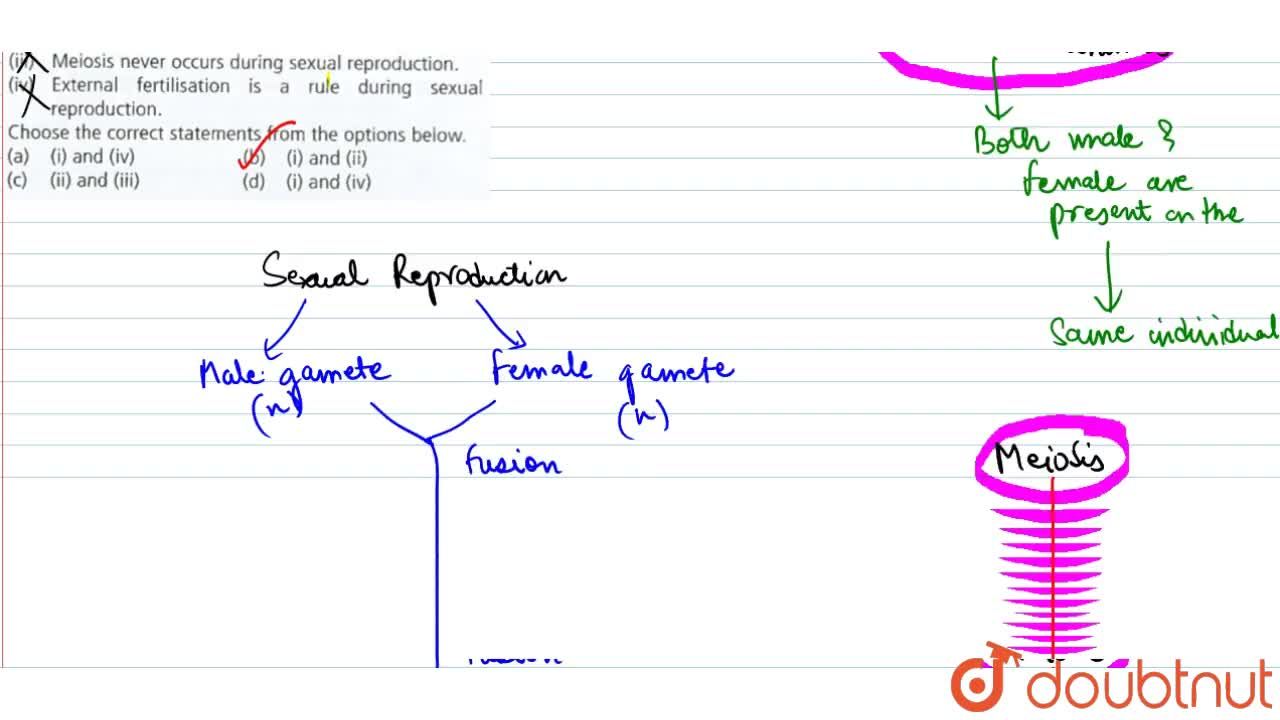Which of the Following Are True Statements Regarding Sexual Reproduction
Which of the following is true about sexual reproduction. Which of the following statements regarding sexual and asexual reproduction is true General.

Solved Seved Click On All Of The True Statements About Chegg Com
A Cell division only occurs after sexual reproduction.

. 2 Asexual reproduction requires _____ individuals. The members of phaeophyceae or brown algae are found primarily in marine habitats. 3 It is generated by mutations A.
B Sexual reproduction typically includes the development of unfertilized eggs. C Cell division only occurs after sexual reproduction. Asexual reproduction produces only haploid offspring.
35 A Sexual reproduction is more likely to increase genetic variation than is asexual reproduction. Cell division only occurs after sexual reproduction. The fusion of the gametes results in the formation of.
Migration is always from one region to another. B-Cell division only occurs after sexual reproduction. Which of the following statements regarding sexual and asexual reproduction is true.
In sexual reproduction individuals transmit half of their nuclear genes to each of their offspring. The correct options are. Is probably maintained in natural populations mostly because of its effect of breaking Mullers ratchet.
Is advantageous in changing environments but disadvantageous in constant environments compared to asexual reproduction. Group of answer choices A. Which of the following statements regarding sexual reproduction are true.
1 It is generated by sexual reproduction and recombination. Correct option is C Sexual reproduction is the process in which two parents are involved which produce two types of gamete ie male and female. CSexual reproduction creates an individual that is a genetic copy of one parent.
D Sexual reproduction is more likely to increase genetic variation than is asexual reproduction. D-Sexual reproduction is more likely to increase genetic variation than is. E none of the above c This.
Which of the following statements regarding genetic variation are true. C-Sexual reproduction typically includes the development of unfertilized eggs. Sexual reproduction in flowers requires two types of gametes namely pollen grains and ovules.
DPopulations of organisms that reproduce through sexual reproduction generally have difficulty adapting to changing environments. A Sexual reproduction is more likely to increase genetic variation than is asexual reproduction. 2 It is necessary for natural selection to operate.
None of the statements are true. A 0 B 1 C 2 D 3 3 Which of the following statements regarding cell division is false. Offspring produced by sexual reproduction are genetically identical.
C Sexual reproduction typically includes the development of unfertilized eggs. Only asexual reproduction results from the union of a sperm and an egg. C Only offspring from asexual reproduction inherit traits from two parents.
A Vegetative reproduction takes place by fragmentation. Haploid cells produced by sexual reproduction are genetically identical. The gametes fuse to form the zygote during fertilization.
Haploid cells formed by meiosis combine to produce a diploid cell. The statements asexual reproduction requires only one parent and budding is an example of asexual reproduction are TRUE about asexual reproduction Options A and B. Sexual reproduction is more likely to increase genetic variation than is asexual reproduction.
Asexual reproduction brings about more genetic diversity compared to sexual reproduktion 2. C Zoospores are pear-shaped and have two unequal laterally attached flagella. Which of the following statements regarding sexual and asexual reproduction is true.
In asexual reproduction offspring are produced by fertilization without meiosis. Hermaphrodites are animals that possess both male and female reproductive systems. D Sexual reproduction may be isogamous anisogamous or oogamous.
Reproductive systems with external fertilization are most common in aquatic animals. Budding is a type of asexual mode of reproduction by which one part of a cellbody in an organism grows and separates from this parental organism to produce two new individuals. B Only offspring from asexual reproduction inherit traits from two parents.
Which of the following statements regarding sexual reproduction is true. 35 Which of the following statements regarding sexual and asexual reproduction is true. The offsprings resulting from asexual reproduction are called clones.
ASexual reproduction produces 2n gametes. C Sexual reproduction typically includes the development of unfertilized eggs. Statement A is true Statement B is false.
Which of the following statements regarding sexual and asexual reproduction is true. BSexual reproduction allows animals to expand their populations faster than asexual reproduction. None of the.
Which of the following statements isare true or false. D Sexual reproduction is more likely to increase genetic variation than is asexual reproduction. Only statement 3 is true.
Haploid cells formed by mitosis combine to produce a diploid cell B. Sexual reproduction generates greater genetic variation than asexual reproduction. B Only offspring from asexual reproduction inherit traits from two parents.
Sexual reproduction requires two haploid gemetes from biological mates whereas offspring that arise from sexual reproduction come from one parent. Which of the following is true regarding sexual and sexual reproduction. Asexual reproduction but not sexual reproduction is characteristic of plants and fungi.
This is a compulsory event which allows the continuation of the species. 662 students attemted this question. A-Only offspring from asexual reproduction inherit traits from two parents.

A Few Statements With Regard To Sexual Reprodction Are Given Below I Sexual Reproduction Does Not Always Require Two Individuals Ii Sexual Reproduction Generally Involves Gametic Fusion Iii Meiosis Never Occurs During

Bio 1320 Chapter 9 Assignment Flashcards Quizlet

Solved Sexual And Asexual Reproduction 3 Click On All Of The Chegg Com
No comments for "Which of the Following Are True Statements Regarding Sexual Reproduction"
Post a Comment